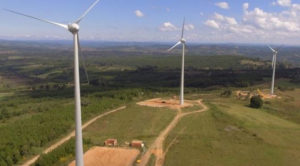by Roger Nellist
Tanzania generates first wind power

In June 2020, in an important first step for Tanzania, a wind farm in Mufindi District generated 0.8 MW of electricity in test production. The wind plant has been developed by the Rift Valley Energy Group (RVEG) and consists of three large wind turbines which, when fully commissioned, are expected to generate 2.4 MW that will ensure affordable power to 32 villages which are currently being supplied by the 4MW Mwenga Hydro Plant. The network is the first private large-scale rural power network in Tanzania and any surplus power is sold to TANESCO under a power purchase agreement.
A spokesman for RVEG said: “The facility will ensure the continued availability of affordable power to the rapidly growing number of rural customers within the network, throughout the year, specifically in the dry season when the available water for the Mwenga Hydro Plant is low…… Additionally, it will cater for further expansion of the rural electricity distribution network into those remaining areas of villages that are located near the rural network area, and are still unconnected”. RVEG offered a discount price of TSh 25,000 (about £9) until October for new customers to get connected.
Mineral Concentrate Exports resume
In May 2020, the government at last granted an export permit allowing 277 containers of gold and copper concentrate material to be released from Dar port for sale abroad by Twiga Minerals Corporation (TMC). The containers had been seized in 2017 following an order by President Magufuli prohibiting their export until unpaid taxes by Acacia Mining and other irregularities at Acacia’s three Tanzanian gold mines had been resolved.
Resolution of those issues came in the form of the suite of agreements that government negotiated with Acacia’s parent company, Barrick Gold. Those agreements were signed in January 2020 and put an end to the acrimonious dispute between the parties that had lasted for three years and significantly disrupted production at the mines. [The protracted saga has been reported in previous editions of TA]. The negotiated settlement has resulted in a radical restructuring of Acacia’s former gold mining operations -with the demise of Acacia, with Tanzania and Barrick becoming shareholders in the new joint venture company (TMC) and with the future economic benefits from mine production being shared (in as yet an unspecified manner).
The technical investigative committee that Magufuli established in 2017 to examine the value of the concentrates estimated that the 277 containers included minerals worth TSh 829 billion. That sum was very considerably more than the amounts declared by Acacia and the Tanzania Minerals Audit Agency.
In a statement Barrick also said that the shipping of some 1,600 containers of concentrate stockpiled from the Bulyanhulu and Buzwagi gold mines resumed in April.
Tanzania receives US$100 million from Barrick
At the end of May, in accordance with the terms of the negotiated settlement between government and Barrick Gold, Barrick paid $100 million (approx. TSh 230 billion) to Tanzania. It was the first tranche of the $300 million that the giant mining company agreed to pay to settle the long-running tax dispute between the parties. When presented with a representative cheque at a ceremony in Dodoma, the Minister for Finance and Planning, Dr Philip Mpango, said: “I congratulate Barrick for implementing our agreement and call upon other mining firms to emulate the move in ensuring a win-win situation”.
Tanzanite gemstone discoveries make latest billionaire
In June 2020, a small-scale miner Mr Saniniu Laizer from Simanjiru in Manyara Region sold two huge Tanzanite gemstones to the government and became Tanzania’s latest Shilling billionaire. With a combined weight of just over 14 kgs, they were valued at TSh 7.7 billion (about $3.4 million). Authorities confirmed that they were the biggest Tanzanites ever to be discovered. Mr Laizer was commended by both President Magufuli and Mines Minister Biteko, who signalled the importance of the small-scale mining sector in the country despite some detractors and that the discoveries proved that Tanzania did not have to be wholly dependent on foreign mining companies. Magufuli, speaking in a broadcast telephone call, said: “Laizer’s incident sends a signal that Tanzania is rich”.
Then Laizer’s luck struck for a third time. In early August, he announced he had discovered a third big Tanzanite stone weighing 6 kgs that was valued at about $2 million.
Tanzanites, which have a dark blue-violet colour, are one of the rarest gemstones on our planet. Remarkably, they are only to be found in Tanzania, where the law specifies that they must be sold to the government.
Williamson Diamond Mine sale?
The Williamson Diamond Mine at Mwadui is owned 25% by the Tanzanian government and 75% by UK-based Petra Diamonds (which also operates three diamond mines in South Africa). However, at the end of June Petra announced that it was facing mounting losses and debts because of depressed global markets, exacerbated by the Covid-19 pandemic (that had apparently caused the price of diamonds to drop from about $246 per carat before the coronavirus outbreak to $135 by March 2020). Petra therefore wished to divest its Tanzanian and South African assets and was also offering itself up for sale – as part of a strategic review of its commercial options.
However, Petra’s announcement seems to have taken the Tanzanian authorities by surprise. Government said it was not given prior notice of the announcement and would block the sale of the Williamson mine since it has a first right of refusal. In response, Petra said it had apologised for its oversight in not first communicating its sale announcement to the government, adding that it was considering all its options to determine what will be in the best interests of the company and its shareholders. Minerals Minister Biteko said government was dissatisfied with the manner in which Petra was going about resolving its problems.
